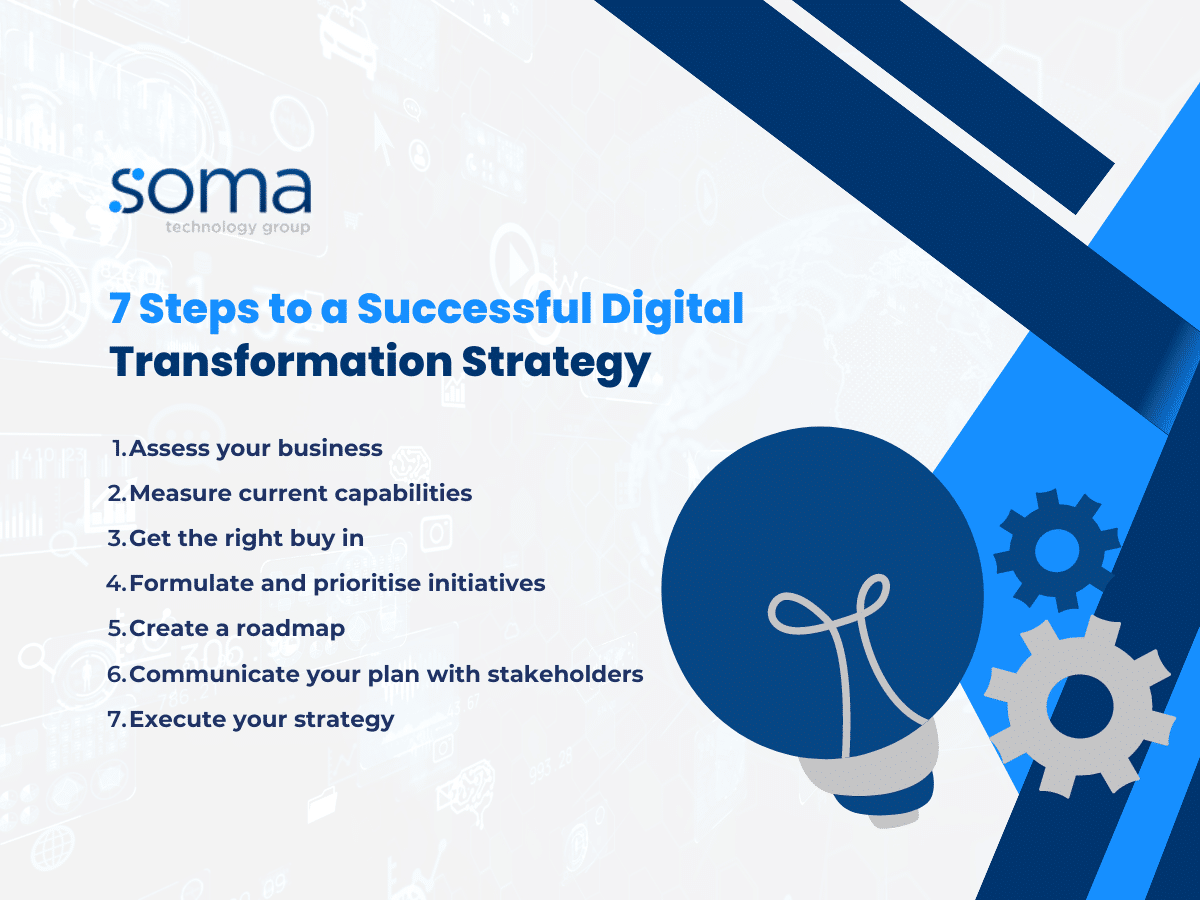Technology and the Internet have forced almost all organisations to digitalise their business, assets, and operations. No matter the industry, it is vital to transform their business from a traditional to a digital and data-driven focused process. And this is where digital transformation comes in.
However, digital transformation is not a walk in the park. It is a journey that takes time to be completed. It is a slow and steady process that takes time, resources, people, and technology. As such, achieving digital transformation requires a precise strategy. One wrong move, it can destabilise the whole operation of your business.
So, to help you with that, in this article, we will guide you to a roadmap that will tackle key elements of the digital transformation strategy.
What is a digital transformation?
Before creating a strategy, it is first essential to know the definition of digital transformation. To simply explain, it is an organisational change effort that leverages digital technologies to reach desired outcomes. It involves using digital technologies to develop or modify business processes to meet the changing needs of a business.
Usually, the main goal of digital transformation is to enhance business performance, increase efficiency and productivity, reduce costs, and improve customer experience.
Why is digital transformation necessary?
As mentioned above, digital transformation is crucial for businesses in today’s rapidly evolving digital landscape. Here are some reasons why a company should implement it.
Enhanced Customer Experience
A well-executed digital transformation enables businesses to deliver seamless and personalised customer experiences. According to a survey conducted by PTC, one of the benefits of digital transformation is that it helps companies meet changing customer expectations.
Through digital technologies, companies can access data and understand customer preferences. This can help them provide tailored customer experiences and anticipate their needs, enhancing customer satisfaction and loyalty.
Aside from this, digital transformation offers a convenient avenue for organisation to interact with their customers anytime, anywhere. Mobile apps, online shopping platforms, and digital payment systems allow customers to conveniently purchase, access services, and engage with businesses.
Increased Operational Efficiency
Digital transformation is not just about digitalisation. It is a process of creating or modifying existing business procedures, culture, and strategy to enhance customer experience and meet the market’s changing needs.
This process also results in improved operational efficiency for companies. It streamlines and automates business processes and operations. Likewise, businesses can eliminate manual tasks, reduce errors, and enhance productivity. This allows employees to focus on high-value activities and accelerates the overall pace of operations.
Competitive Advantage
Let’s face it. Most business owners utilise the digital and social landscape to operate their businesses. According to Gartner, about 91% of companies are engaged in some kind of digital project. Suppose you are part of the population not using the virtual arena to conduct business. In that case, you are clearly missing out.
Embracing digital transformation helps businesses stay ahead of the competition. Through technology and the Internet, companies can quickly introduce new services, enter new markets, and remain in contact with their customers. This enables businesses to differentiate themselves from competitors, attract new customers, and create a sustainable competitive advantage.
Data-driven Decision Making
Digital Transformation in business provides access to vast quantities of data that can be leveraged for informed decision-making. Companies can gain valuable insights into client behaviour, market trends, and operational performance by implementing data analytics and business intelligence tools. These insights enable businesses to make data-driven decisions and identify new growth opportunities.
7 Steps to A Successful Digital Transformation Strategy
Digital transformation without a strategy is destined to fail. Without a clear strategy guiding the change, organisations risk wasting resources, losing direction, and failing to achieve their desired outcomes. According to a study conducted by McKinsey, about 70% of digital transformations fail.
Likewise, before driving into execution, one must create a strategy tailored to their needs, capability, and goals. Here are some steps to help you with that.

1. Assess your business
The initial step in developing a successful digital transformation strategy is to assess your business. Before embarking on any transformational journey, it is crucial to have a comprehensive understanding of your current state, challenges, and opportunities.
Assessing the business provides a clear understanding of the current state of operations, processes, and technologies. It helps identify the strengths, weaknesses, and areas that require improvement. This understanding is a starting point for identifying areas where digital transformation can have the most significant impact.
Here’s why assessing your business is essential:
- Identify Pain Points. This should include evaluating existing processes, systems, and technologies that may hinder growth or inhibit customer experience. Understanding these pain points is crucial for targeted improvements during the transformation.
- Define Objectives. Establish specific goals aligned with your overall business strategy. These will guide you during your digital transformation journey and keep your company focused on achieving these goals.
- Understand Customer Needs. Analyse customer preferences, expectations, and behaviours. Through this, you can understand their pain points and identify opportunities for improvement in digital solutions.
2. Measure current capabilities
Assess existing technologies and employee capabilities. Determine if you need any additional skills or training for the digital transformation. You should also evaluate the compatibility of your current system with the latest digital technologies. This would help you plan your resource allocation and planning.
3. Get the correct buy-in
The “buy-in” for digital transformation refers to gaining support, commitment, and endorsement from key organisational stakeholders. It involves gaining the acceptance and approval of decision-makers, leaders, employees, and other relevant parties who play a role in the transformation process.
The buy-in signifies their belief in digital transformation’s value, importance, and willingness to participate and contribute to its success actively. This is critical to starting a digital transformation project as it ensures a suitable organisational investment. Here are some essential considerations for achieving the proper buy-in:
- Obtain leadership Support. Obtaining buy-in from top-level executives and leaders is essential. They need to understand the importance of digital transformation, its potential benefits, and alignment with the organisation’s strategic goals.
- Communicate the vision. Effective communication helps stakeholders understand the value of digital transformation and encourages their active involvement. You should also demonstrate the return on investment (ROI) and the potential value generated through it. This helps stakeholders understand the benefits and justifies their support.
- Collaborate and include the right stakeholders. Involve stakeholders from different departments and levels of the organisation throughout the transformation process. Seek their input, ideas, and feedback to ensure a sense of ownership and inclusion. Collaborative decision-making fosters a collective understanding and commitment to the transformation efforts.
- Pilot a small-scale project. Try to execute a minor part of the project to showcase the feasibility of digital transformation. These tangible examples of success can help gain buy-in from stakeholders who may be initially hesitant or sceptical.
4. Formulate and prioritise initiatives
After the capability assessment, it’s time to list actions to fill capability gaps and pain points. Take a closer look at the necessary measures and sort them into groups. These will act as your projects, programs, and initiatives. Then, prioritise your initiatives based on their impact and estimated effort. Start with simpler projects that focus on essential features, allowing you to test the viability of your digital solution.
5. Create a roadmap
A roadmap helps prioritise digital initiatives based on their impact and feasibility. It enables organisations to identify and focus on high-priority projects that deliver maximum value and address critical pain points. Likewise, it serves as a guiding document that outlines the path toward successful digital transformation, enabling organisations to navigate the complexities, make informed decisions, and achieve their digital goals effectively.
The roadmap also provides a sequence for implementing different initiatives, considering dependencies, resource availability, and potential risks. This prioritisation ensures that digital transformation efforts are executed logically and efficiently.
6. Communicate your plan with stakeholders
Informing your employees and leader about your action will motivate them to support and patronise your digital transformation strategy. If people understand what is happening and how it can help the company, they will more likely support these changes.
Likewise, when communicating your digital transformation plan to stakeholders, it’s crucial to ensure clarity, engagement, and alignment. Here are some steps to effectively communicate your plan:
- Identify your stakeholders. This could include executives, department heads, customers, employees, and other partners.
- Develop a Clear and Compelling Message. Craft a concise and compelling message that clearly articulates the it’s purpose, benefits, and expected outcomes.
- Select appropriate communication channels. This could include town hall messages, workshops, webinars, newsletters, etc.
- Anticipate potential concerns, scepticism, or resistance. Be prepared to answer any inquiries on risk, impacts, and timeline.
7. Start your digital transformation
After identifying the fundamentals of your digital transformation strategy, it’s time to get it approved and execute it. Remember to stick to the plan and regularly review your roadmap to see if things are on track.
Also, try to consider any issues and refine your strategy.
Start Your Digital Transformation with Soma
A well-planned and executed digital transformation strategy empowers businesses to embrace digital technologies, drive innovation, enhance customer experiences, and achieve sustainable growth in the digital era.
So, are you ready to embark on a successful digital transformation journey? At SOMA Technology Group, we offer cutting-edge services tailored to your unique business needs.
Check out how we helped a community college throughout its digital transformation journey.



